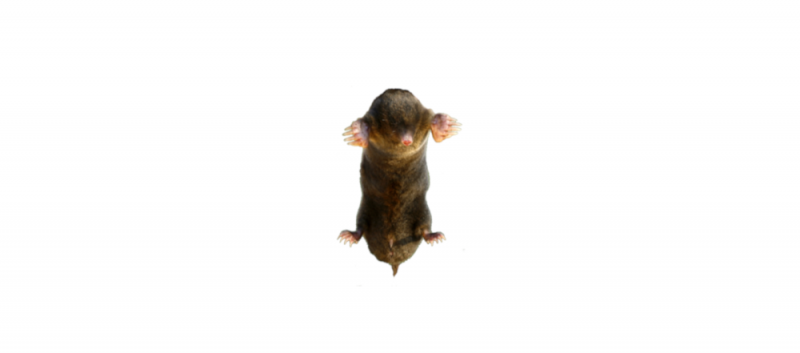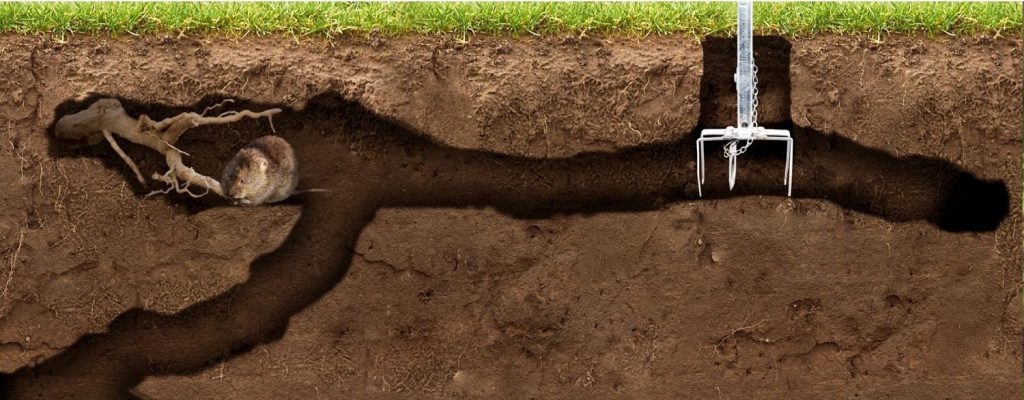How to get rid of Moles

Moles are small mammals, adapted to underground life. They have a cylindrical body with a short tail and short, robust limbs. They have a long snout, almost glabrous and very mobile, extending beyond the upper lip. Most mole species do not have external ears, while their eyes are small and hidden in the fur. Because of this, they have poor eyesight, but their hearing and tactile senses are well developed. The snout is provided with thousands of microscopic tactile papillae (Eimer’s organs), with the help of which the moles detect and differentiate the details of the environment and their prey. The forelimbs, in most species, are oriented outwards and are provided with large claws, adapted for digging. Terrestrial moles feed mainly on earthworms, but also consume other small invertebrates.
In general, the moles are active all year round (day and night), following several cycles of activity and rest. However, they display a lower activity during periods of extreme heat or cold. They are the most active after periods of rain and high humidity, when the soil texture is ideal for digging. Most of the time, they dig tunnels in search for food. These tunnels tend to follow the edges of buildings, fences, etc. They rarely come to the surface to gather shelter materials. From time to time, the moles push the loose soil to the surface, forming molehills.
They are considered harmful to human activities, such as agriculture, landscaping and gardening. Although they do not affect the roots of the plants, the tunnels and molehills created destroy the aesthetic appearance of the lawns, gardens and sports fields. However, the moles bring benefits to gardens and the ecosystem by aerating the soil and consuming snails and other pests that feed on plant roots.
Signs of the presence of moles
- The presence of conical molehills, with a diameter of 15, up to 50 cm and a height of about 20 cm, with covered entrances.
- The presence of the moles’ paths, in the form of irregular soil elevations, with a width of about 5 cm, caused by their digging of tunnels.
Mole traps
They are placed inside the galleries, along them or fixed in the ground, perpendicular to them. It is important to place the traps during the periods when the moles are most active (between 16-18 or after rain / watering the soil).
The traps are placed in the active galleries, using gloves so that the animals do not detect the human smell. The active galleries of the moles are those that intersect at the end with other galleries, forming a system. Galleries that end abruptly or have mouse holes or cracks are most likely abandoned. To find out if a gallery is active, you can step on the ground above it, forming a superficial hole, and check if, in 12-24 hours, the mole retraced its course.
Recommended products
-
You can find products on a different store
Change Store -
You can find products on a different store
Change Store -
You can find products on a different store
Change Store -
You can find products on a different store
Change Store -
You can find products on a different store
Change Store -
You can find products on a different store
Change Store -
You can find products on a different store
Change Store -
You can find products on a different store
Change Store -
You can find products on a different store
Change Store -
You can find products on a different store
Change Store -
You can find products on a different store
Change Store -
You can find products on a different store
Change Store -
You can find products on a different store
Change Store -
You can find products on a different store
Change Store -
You can find products on a different store
Change Store -
You can find products on a different store
Change Store -
You can find products on a different store
Change Store -
You can find products on a different store
Change Store -
You can find products on a different store
Change Store -
You can find products on a different store
Change Store -
You can find products on a different store
Change Store -
You can find products on a different store
Change Store -
You can find products on a different store
Change Store -
You can find products on a different store
Change Store
Mole repellents
Repellents are used to keep the moles away from the protected area. They are inserted inside the galleries, at all their entrances, and are reapplied depending on the severity of the infestation.
Recommended products
-
You can find products on a different store
Change Store -
You can find products on a different store
Change Store -
You can find products on a different store
Change Store -
You can find products on a different store
Change Store -
You can find products on a different store
Change Store -
You can find products on a different store
Change Store -
You can find products on a different store
Change Store -
You can find products on a different store
Change Store -
You can find products on a different store
Change Store -
You can find products on a different store
Change Store -
You can find products on a different store
Change Store -
You can find products on a different store
Change Store -
You can find products on a different store
Change Store -
You can find products on a different store
Change Store -
You can find products on a different store
Change Store -
You can find products on a different store
Change Store -
You can find products on a different store
Change Store -
You can find products on a different store
Change Store -
You can find products on a different store
Change Store -
You can find products on a different store
Change Store -
You can find products on a different store
Change Store -
You can find products on a different store
Change Store -
You can find products on a different store
Change Store -
You can find products on a different store
Change Store
The effective control of the moles in a certain field consists in capturing them with the help of specific traps and protecting the area with the help of repellents. Thus, it is very important to know the biology of the animal to detect the tunnels and its periods of activity.
















































































































































































































































































































































































































































